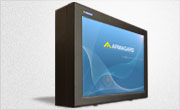Back-lit LED – the Future of Outdoor Digital Signage – is Bright
Posted by: Richard Williams | Posted on: | 1 Comments
Modern flat screen technology commonly used in digital signage such as plasma and LCD is relatively new and while the advantages of these displays compared to the old style cathode ray tube are quite obvious; flatter, smaller, lighter, cheaper to produce etc, they are not by any means perfect.
As well as home entertainment, LCD and plasma displays are commonly used for digital signage as a more dynamic method of displaying information and advertising.
Traditional LCD displays do have a few downsides when used for signage purposes, particularly when used for outdoor digital signage. These are three-fold:
Brightness
Traditional LCDs typically can generate 500 nits (or candelas per square metre = equivalence of the number of candles that would emit that light)
Reliability
Traditional LCDs, even commercial grade ones designed for continual use do not last as long as home TVs. Part of the problem is that they are continually on and even when they are housed in outdoor LCD enclosures the screens can fail after several years of continual use.
Energy Consumption
LCD and plasma displays are also quite power hungry and this one of the reasons they suffer reliability problems because of the heat often generated by constant use.
However, the growing popularity of back-lit LED screens may make conventional LCD and plasma screens a thing of the past, especially for the digital signage market. Not only do back-lit LED TVs operate with much lower power consumption they are also far more reliable and can easily last a decade in a decent outdoor digital signage enclosure – even if left constantly on.
But the biggest plus of a back-lit LED TV over conventional LCD systems is the brightness. Compared to the 500 nit output of a LCD, a backlit LED can produce 1,500-2,000 nits producing a much brighter image which makes them an ideal solution for outdoor digital signage.
Post shortlink:
Popular Products
LCD Enclosure
Need armor for your LCD/LED screen(s)? Outdoors or inside the versatile LCD enclosure protects against thieves, vandals & the weather. Installation idea: NFL stadiums.
Outdoor Digital Signage
Exclusive 46” outdoor screen protection. Dubbed the ‘Totem’, due to its distinct design, it repels damage threats, but attracts audiences. Installation idea: Drive-thru restaurants.
Portrait Flat Panel Enclosure
Safeguard your eye-level advertising display screen(s), indoors or outdoors. Completely customizable, add exciting features like touch screen technology. Installation idea: Restaurant frontages.
Indoor Digital Signage
Popular purchase for retail outlets! Great for ‘point of sale’ persuasion, boost your brand with static & motion advertising from a single unit! Installation idea: Mall of America.




